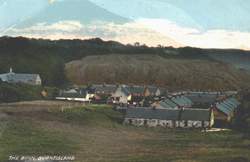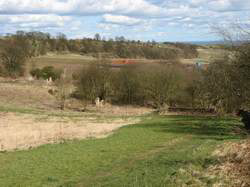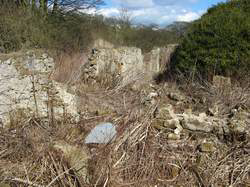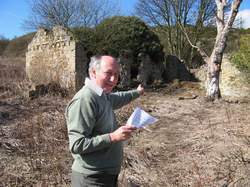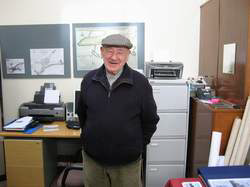Abandoned Communities ..... Binnend
The shape of the hillside close to Binnend has changed several times over the last century. Photographs of the High Binn taken early in the twentieth century show the huge mound of spent shale on the eastern side of the houses. This mound was gradually removed to be used as rubble in the construction and road building industries. In 1989 Alcan Chemicals were given permission to dump 1.6 million tons of red mud. The red dump, clearly visible on the aerial view supplied by Google Maps, covered the western end of the previous shale dump and also the eastern part of the High Binn, including seven terraces of houses and the football pitch. In recent years a lot of the red mud has been removed, and at the time of my visit in April 2008 the area was undergoing large scale landscaping.
The remnants of the buildings on the west side of the High Binn can still be seen today. A lot of the stone has been removed for re-use elsewhere, but in several places walls in various stages of decay are still there. They will be more visible and easier to walk around during winter and early spring. You can get up to them by a footpath from the B923 that follows the track once used by the people of Binnend to go to Burntisland. Another possibility is to climb the hill via National Cycle Route 1, but this is not an option I would recommend either to walkers or to cyclists, not because of the gradient, but because the centre of the track has already been worn into a deep furrow that may be filled with water.
When you reach the village you may be able to make out what used to be The Square on the left hand side. The Square consisted of two rows of houses running east to west, with an area of open ground between them, and another terrace of houses running north to south at the western end of The Square. The remains of what appear to have been more impressive houses can be seen above The Square, and then further ruins that may lie on the site of the mission hall and the church.
I went to Binnend with Ian Archibald of the Burntisland Heritage Trust. Ian also introduced me to Jimmy Wilson, now 92, who moved to Binnend with his mother and sister in 1922. His father had been killed in World War I. The family lived in Binnend until 1934, when Jimmy was 19. Jimmy slept in the back room, while for most of the year his mother and sister slept in recesses in the front room, or kitchen. In the summer his mother and sister would often have to join him in the back room as the kitchen was let out to holiday visitors. When he needed a wash Jimmy would make use of a tub in the communal laundry area, having first rigged up a blanket over the window. One task performed by his mother was to collect the rent from the residents of the High Binn and deliver it to the offices of the Whinnyhall Estate in Edinburgh. Jimmy went to school in Burntisland, and left at the age of 14 to become an apprentice to a butcher.
For further reminiscences by Jimmy Wilson, and photographs of him at Binnend with his sister and various friends, see the book Burntisland Voices, mentioned earlier. Or go to the BBC Website to see Jimmy in 2010 taking part in a programme about the changing landscape of Scotland.
The remnants of the buildings on the west side of the High Binn can still be seen today. A lot of the stone has been removed for re-
When you reach the village you may be able to make out what used to be The Square on the left hand side. The Square consisted of two rows of houses running east to west, with an area of open ground between them, and another terrace of houses running north to south at the western end of The Square. The remains of what appear to have been more impressive houses can be seen above The Square, and then further ruins that may lie on the site of the mission hall and the church.
I went to Binnend with Ian Archibald of the Burntisland Heritage Trust. Ian also introduced me to Jimmy Wilson, now 92, who moved to Binnend with his mother and sister in 1922. His father had been killed in World War I. The family lived in Binnend until 1934, when Jimmy was 19. Jimmy slept in the back room, while for most of the year his mother and sister slept in recesses in the front room, or kitchen. In the summer his mother and sister would often have to join him in the back room as the kitchen was let out to holiday visitors. When he needed a wash Jimmy would make use of a tub in the communal laundry area, having first rigged up a blanket over the window. One task performed by his mother was to collect the rent from the residents of the High Binn and deliver it to the offices of the Whinnyhall Estate in Edinburgh. Jimmy went to school in Burntisland, and left at the age of 14 to become an apprentice to a butcher.
For further reminiscences by Jimmy Wilson, and photographs of him at Binnend with his sister and various friends, see the book Burntisland Voices, mentioned earlier. Or go to the BBC Website to see Jimmy in 2010 taking part in a programme about the changing landscape of Scotland.
Five
The High Binn from the west, with the shale dump in the background
Taken from a similar position in April 2008
Ian Archibald
Jimmy Wilson
Ruined houses
